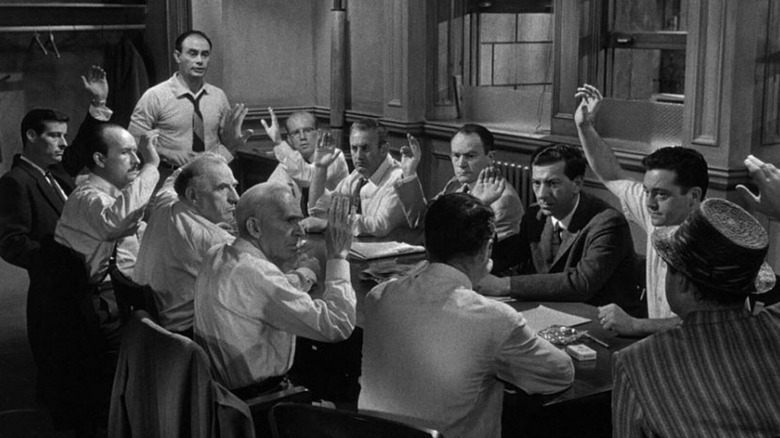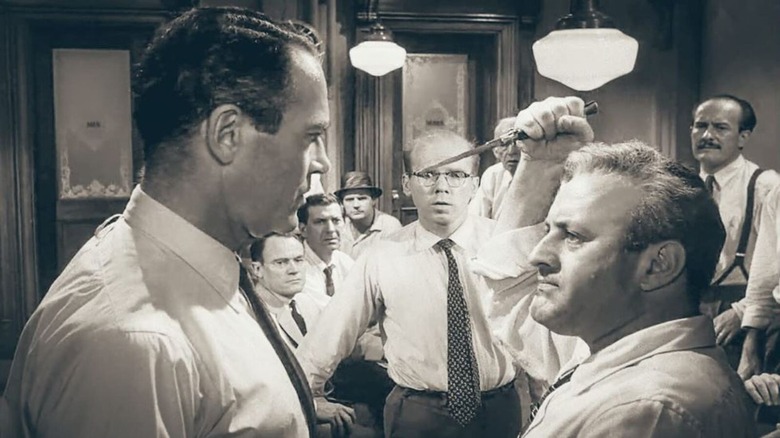How Sidney Lumet Used His One Room Setting In 12 Angry Men To His Advantage
Besides his work on the 1978 Diana Ross and Michael Jackson-starring cult classic "The Wiz," I know the late, great director Sidney Lumet for his legal/courtroom dramas such tas "The Verdict" and "Find Me Guilty." I was first introduced to such works in college when a criminal justice professor showed my class Lumet's first feature film, "12 Angry Men." The movie allows viewers to become flies on the wall as a jury who, on the hottest day of the year, is sent into the deliberation room to unanimously decide whether to send an 18-year-old murder suspect to the electric chair.
Though the then 33-year-old Lumet had the simple goal of just getting his first feature film under his belt, "12 Angry Men" would go on to become one of the director's greatest films. For me, a feature about 12 hot and sweaty jurors doing their civic duty in a cramped room sounds like a pain to sit through, but "12 Angry Men" is no snooze fest, thanks in part to the outstanding performances by its leading actors: Henry Fonda, Martin Balsam, Lee J. Cobb, Jack Warden, Ed Begley, Joseph Sweeney, George Voskovec, Robert Webber, Edward Binns, Jack Klugman, John Fiedler, and E. G. Marshall. But Lumet never viewed shooting the movie in a single room as an obstacle. In fact, he used the setting to his advantage.
The sense of entrapment
In the film, as expected, the jurors don't reach a unanimous vote right out of the gate. While 11 initially vote guilty, one holdout eventually turns into two, and then three, and so on. The jurors become frustrated with one another and tempers flare as they begin to feel jailed in the deliberation room (one juror has tickets to the Yankees game but can't go until a verdict is reached).
Lumet sought to emphasize this sense of entrapment with the use of certain camera angles. The first few times I saw "12 Angry Men," I didn't key into the cinematography that much. I did notice, however, that the camera moves around a lot as it follows one talking character to the next, which I assumed was done to keep viewers engaged in the one room setting. But when I watched the film for the fourth or fifth time, I realized the camera movements were more sophisticated and strategic than that.
Lumet used different eye levels to create tension. As the movie progresses, the director shifts to longer lenses to make the room feel smaller and smaller. "Make it more claustrophobic," Lumet once said, according to Cinephilia & Beyond. "Make the ceiling feel lower, make it seem as if the walls are closing in on them. We weren't kidding anybody. We were going to be in one room. Let's use it dramatically!"
The camera angles complement the dialogue
Earlier, I lauded the leading actors' performances, but I have to note that the raw and authentic dialogue by the author of the screenplay, Reginald Rose, who gave the actors plenty to work with. The performances and the dialogue work hand-in-hand to slowly build tension; that's what struck me the first few times I saw the movie. When the gentlemen first enter the deliberation room, for example, there's a small confusion over when and how to begin deliberations. Then there's a minor spat about seating arrangements and talking out of turn.
As the movie progresses, these minor conflicts involve into more serious points of contention: one juror's upbringing is attacked; another is accused of being prejudiced. By the end of the film, we see shouting matches, near fights, and emotional breakdowns. Lumet used the camera angles in the one room setting to extenuate the rise in tension. As Sidney Lumet wrote in his 1995 book "Making Movies" (via Cinephilia & and Beyond):
"I shot the first third of the movie above eye level, and then, by lowering the camera, shot the second third at eye level, and the last third from below eye level. In that way, toward the end, the ceiling began to appear. Not only were the walls closing in, the ceiling was as well. The sense of increasing claustrophobia did a lot to raise the tension of the last part of the movie."
"12 Angry Men" is a masterclass on how to meld the core elements of filmmaking to produce the perfect movie. And considering that the movie was made on a budget of just $350,000, it is also a lesson on how to make the most of what you've got.


